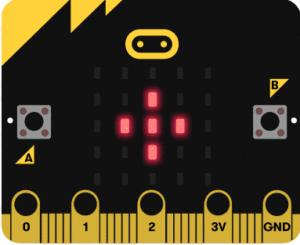
The BBC micro:bit is a small computing device for children. The microbit can be used to develop unique creations from robots to musical instrument and more. This BBC micro:bit course at Cycloid Academy brings computer science education to children and guide them to started along the path of programming hardware.
You will learn the coding with the BBC micro:bit and MakeCode programme with the use of a number of onboard functions in the BBC micro:bit. The board itself has several input options, functional sensors and displays such as push buttons, an onboard light sensor, temperature sensor, accelerometer, magnetometer, and a compass in addition to Bluetooth capability and Radio functions. The board also features an array of LEDs that can be programmed to light up as shown in the diagram on the left side.
The BBC micro:bit can also be interfaced with a wide range of additional sensors. This course also introduces you to many of these sensors and how they work. You will then use these sensors to develop the following projects:
- Project #1: A scrolling name tag
- Project #2: Animated LED displays
- Project #3: A high-tech compass
- Project #4: A handheld tilting game
- Project #5: A carnival strength tester
- Project #6: A powered cooling fan helmet
- Project 7# An electronic musical instrument
- Project 8# A security system that sends alarms
- Project #9: Make Your BBC Micro:Bit Talk
- Project #10: Radio Control Project
- Project #11: Drawing robot
- Project #12: Line following robot
- Project #13: intelligent object avoiding robot
- Project #14: Radio-controlled robot
Once you have completed these projects, you will move to an advanced project using a robot kit. You will be introduced to buggy robotics and learn to program a buggy robot similar to that displayed on the left. You will learn to use all its features, its movement, navigation and how to utilise light and sound, obstacle detection and avoidance and to program the buggy to follow a line. When you learn to use it in conjunction with the micro:bit's radio features, you will also learn to remotely control the buggy and command it to perform certain actions.
- This course will get you started with hardware programming using the BBC micro:bit.
- You will learn how to configure input and outputs.
- You will learn basic programming functions such as if else commands, for loops, variables, storage and mathematical and logic operations.
- You will also learn the information from sensors to make decisions and perform operations using the BBC micro:bit.
- You will develop nine projects and in the final stage develop number of projects using buggy robot platform.
This course is delivered for 12 weeks with weekly activities coordinated via the Moodle platform
12 weeks with approximately 1 to 2 hours of guide video, 5 to 6 hours of self experiments using the BBC micro:bit. Weekly help sessions at preschduled time.
This course is suitable for beginners in computer programming. It is ideal for high school students and undergraduate students taking STEM courses intending to forge a career in STEM.
Submit Expression of Interest to next enrolment date
AUD 140 for course ($265 total with all devices and accessories)
Note: breakdown of cost of devices
- The micro:bit board: $30
- Minor accessories: $35
- Buggy robot platform $50
- Shipping : Variable approximately: $10
Course Content:
- Introduction to the BBC micro:bit
- Makecode editor and Python editors for programming
- Inputs, outputs, and functionality in the BBC micro:bit
- Delivery: Weekly video on Moodle platform + Instructor help session
- Working with the built-in display
- Turning LEDs on and off
- Using build-in images
- Creating your own images
- Animations
- Project #1: A scrolling name tag
- Project #2: Animated LED displays
- Delivery: Weekly video on Moodle platform + Instructor help session
- Introduction to the accelerometer
- Reading Acceleration
- Building a Spirit Level
- Calculating Overall Acceleration
- Gesture Detection
- Detecting the Current Gesture
- Getting Gesture History
- Introduction to the Compass
- Calibrating the Compass
- Reading Compass Values
- Getting Compass Heading
- Project #3: A high-tech compass
- Project #4: A handheld tilting game
- Delivery: Weekly video on Moodle platform + Instructor help session
- Advanced use of conditional statements such as if / else and loops
- Project #5: A carnival strength tester
- Project #6: A powered cooling fan helmet
- Delivery: Weekly video on Moodle platform + Instructor help session
- Connecting a Speaker
- Using Earphones
- Built-in Melodies
- Making Your Own Melodies
- Using Octave
- Beats
- Setting the Tempo
- Getting the Tempo
- Resetting Attributes
- Playing a Pitch
- Project 7# An electronic musical instrument
- Project 8# A security system that sends alarms
- Delivery: Weekly video on Moodle platform + Instructor help session
- Working with Speech
- Connecting a Speaker
- Timbre
- Example: Creating a Robotic Voice
- Punctuation
- Phonemes
- Stress Markers
- Singing with Phonemes
- Project #9: Make Your BBC Micro:Bit Talk
- Delivery: Weekly video on Moodle platform + Instructor help session
- Building a Wired Network
- Buffering Incoming Data
- Using Radios
- Turning the Radio On and Off
- Sending and Receiving Messages
- Configuring Radio
- Remotely Controlling an LED
- Project #10: Radio Control Project
- Delivery: Weekly video on Moodle platform + Instructor help session
- Introduction to the buggy platform
- Use of buggy servo DC motors with variable speed control
- Utilize light and sound, obstacle detection and avoidance
- Project #11: Drawing robot
- Project #12: Line following robot
- Project #13: intelligent object avoiding robot
- Project #14: Radio-controlled robot

